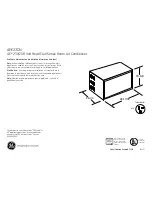
508296-G01 / 31-5000753
Page 21 of 24
Issue 2231
Checking Refrigerant Charge
The NS23AMA unit is factory-charged with enough HFC-
410A refrigerant to accommodate a 15-foot length of
refrigerant piping. For refrigerant piping greater than 15
feet, calculate the additional charge using Table 9. Then
add the additional charge specified for the specific indoor
coil match-up listed on the unit charging sticker.
When charging the system with refrigerant or checking
refrigerant, the “Charge Mode” (CHRG MODE) jumper
provides the ability operate the unit at 100% capacity. See
Charge Mode Jumper section on Page 18 for details.
Charge should be checked and adjusted using the
tables provided on the charging procedure sticker on the
unit access panel. Detailed information is given in the
NS23AMA Service Manual.
Liquid Line Dia.
Ounces per 5 feet (G per 1.5 m)
Adjust from 15 feet (4.6 M) Line Set*
3/8" (9.5 mm)
3 ounces per 5' (85 G per 1.5 m)
*If line length is greater than 15 ft. (4.6 m), add this amount. If
line length is less than 15 ft. (4.6 m), subtract this amount.
NOTE – Insulate liquid line when it is routed through areas
where the surrounding ambient temperature could become
higher than the temperature of the liquid line or when
pressure drop is equal to or greater than 20 psig.
Table 9. Refrigerant Charge per Line Set Length
High Pressure Switch
This unit is equipped with a high pressure switch which
is located on the liquid line. The SPST, normally closed
pressure switch opens when liquid line pressure rises above
the factory setting of 590 +/- 15 psig and automatically
resets at 418 +/- 15 psig.
Homeowner Information
ELECTRICAL SHOCK HAZARD!
Turn OFF electric power to unit before performing any
maintenance or removing panels or doors.
FAILURE TO DO SO COULD RESULT IN BODILY
INJURY OR DEATH.
WARNING
In order to ensure peak performance, your system must
be properly maintained. Clogged filters and blocked airflow
prevent your unit from operating at its most efficient level.
The system should be inspected and serviced before each
cooling season by a licensed professional HVAC service
technician (or equivalent).
Homeowner Maintenance
The following maintenance may be performed by the
homeowner.
• Contact a licensed professional HVAC technician to
schedule inspection and maintenance appointments
for your equipment before each cooling season.
•
Check the indoor unit filter each month and replace
the filter, if necessary.
• Have your technician show you where your indoor
unit filter is located. It will be either at the indoor unit
(installed internal or external to the cabinet) or behind
a return air grille in the wall or ceiling. Check the filter
monthly and clean or replace it as needed. Disposable
filters should be replaced with a filter of the same type
and size.
•
Check the indoor unit drain line for obstructions
monthly. The indoor coil is equipped with a drain pan
to collect condensate formed as your system removes
humidity from the inside air. Have your dealer show
you the location of the drain line and how to check
for obstructions. (This would also apply to an auxiliary
drain, if installed.)
• Check the area around the outdoor unit monthly and
remove any obstructions that may restrict airflow to
the outdoor unit. This would include grass clippings,
leaves, or papers that may have settled around the
unit.
• Trim shrubbery away from the unit and periodically
check for debris which collects around the unit.
• During the winter months, keep the snow level below
the louvered panels.
NOTE:
The filter and all access panels must be in place
any time the unit is in operation. If you are unsure about
the filter required for your system, call your technician for
assistance.
Sprinklers and soaker hoses should not be installed
where they could cause prolonged exposure to the
outdoor unit by treated water. Prolonged exposure of the
unit to treated water (i.e., sprinkler systems, soakers,
waste water, etc.) will corrode the surface of the steel
and aluminum parts, diminish performance and affect
longevity of the unit.
IMPORTANT
Thermostat Operation
See the thermostat homeowner manual for instructions on
how to operate your thermostat.




































